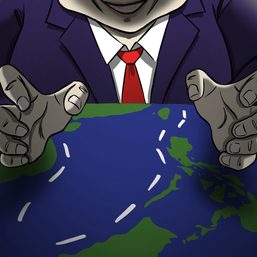SUMMARY
This is AI generated summarization, which may have errors. For context, always refer to the full article.
![[OPINION] Revisiting the July 12, 2016 arbitral award](https://www.rappler.com/tachyon/2023/07/justice-carpio-TL-july-12-2023.jpg)
Retired Justice Antonio Carpio delivered these remarks at a forum convened by the Stratbase ADR Institute to mark the seventh anniversary of the July 12, 2016 arbitral award on the South China Sea arbitration. Rappler is republishing this with his permission.
Every year that we celebrate the landmark July 12, 2016 arbitral award on the South China Sea arbitration, we see more countries supporting the award and demanding that China, as a member of the UN Convention on the Law of the Sea or UNCLOS, must abide with the award. The hallmark of a great decision is that it becomes more entrenched in jurisprudence with the passage of time. This is true with the arbitral award.
There is an obvious reason why the arbitral award can only gather more support in the future among member-states of UNCLOS. If China under its nine-dash line can claim almost the entire South China Sea, then UNCLOS cannot apply in the South China Sea. If UNCLOS cannot apply in the South China Sea, then UNCLOS cannot also apply in the other seas of our planet. Nuclear-armed or militarily powerful states will emulate China and just seize the maritime zones of their weaker or smaller neighboring states.
That would mean the end of UNCLOS, the convention that guarantees and protects the exclusive economic zones and extended continental shelves of all coastal states in the world – the vast majority of whom are small and medium-sized states. It is a matter of self-preservation and self-interest for these vast majority of small and medium-sized states to support the arbitral award to prevent the collapse of UNCLOS. More and more citizens of small and medium-sized states will realize this over time.
Now, I will proceed to my task today – to restate the arbitral award’s core rulings that have generated, or should have generated, the most attention from coastal states.
First, of course, is the ruling that China’s nine-dash line has no legal effect in determining maritime zones under UNCLOS. To do justice to the enormity of this ruling, let me quote the precise words of the arbitral tribunal in striking down China’s nine-dash line:
“xxx the Tribunal DECLARES that, as between the Philippines and China, China’s claims to historic rights, or other sovereign rights or jurisdiction, with respect to the maritime areas of the South China Sea encompassed by the relevant part of the ‘nine-dash line,’ are contrary to the Convention and without lawful effect to the extent that they exceed the geographic and substantive limits of China’s maritime entitlements under the Convention; and further DECLARES that the Convention superseded any historic rights, or other sovereign rights or jurisdiction, in excess of the limits imposed therein.”
This resounding ruling will echo throughout history amidst the whispering waves of the South China Sea.
Maritime zones under UNCLOS – like the exclusive economic zone (EEZ) of the Philippines in the West Philippine Sea (WPS) – are determined solely by the provisions of UNCLOS: 12 nautical miles (NM) for the territorial sea and 200 NM for the EEZ, both measured from baselines determined in accordance with UNCLOS, and 150 NM for the extended continental shelf (ECS) measured from the outer limits of the EEZ. Under UNCLOS a coastal state can only claim maritime zones as expressly allowed under UNCLOS. To ensure peace and stability in the seas of our planet, UNCLOS extinguished all historic claims beyond the territorial sea, including China’s nine-dash line, which is actually fictional.
China’s nine-dash line is not measured from the baselines of China as determined under UNCLOS. China’s nine-dash line claim waters and resources beyond what UNCLOS allows. Thus, China’s alleged historic claim to maritime zones under its nine-dash line has no basis whatsoever under UNCLOS. In short, the arbitral tribunal ruled that China can only claim maritime zones expressly allowed under UNCLOS, and consequently China’s nine-dash line cannot serve as legal basis to claim any of the waters or resources of the South China Sea.
Second, the arbitral tribunal ruled that the 46-hectare Itu Aba, the largest island in the Spratlys, is not capable of human habitation. Under UNCLOS, an island must be capable of human habitation based on its own natural resources to generate a 200 NM EEZ. Thus, the rest of the high-tide features in the Spratlys, which are all much smaller than Itu Aba, do not also generate EEZs but only 12-NM territorial seas just like Itu Aba.
This means that there are no overlapping EEZs between Palawan and any of the geologic features in the Spratlys. Had there been an overlapping EEZ, the arbitral tribunal would have no jurisdiction over the maritime dispute, and would have dismissed the case, at least for the area off the coast of Palawan. China had opted out of compulsory arbitration in 2006 in case of overlapping maritime zones requiring “sea boundary delimitation.” This specific opt out is allowed under UNCLOS.
This is the first case where an international tribunal explained what constitutes a habitable island that can generate a 200-NM EEZ. Because of this ruling, many coastal states can no longer claim 200-NM EEZs for their tiny islands that do not meet the criteria of a habitable island. All these tiny or uninhabitable islands are entitled only to 12-NM territorial seas.
In effect, this ruling has expanded considerably the high seas in our planet. In the high seas, there is freedom of fishing for all states of the world. Since China has the largest fishing fleet in the world, China has actually gained more fishing grounds than it has lost under the arbitral award.
Putting together the ruling that China’s nine-dash line cannot serve as legal basis to claim any of the waters or resources of the South China Sea, as well the ruling that none of the high-tide features in the Spratlys generate an EEZ, we come to the inescapable conclusion that the Philippines has a 200-NM EEZ in the WPS unimpaired by China’s nine-dash line. However, excluded from this Philippine EEZ are the 12-NM territorial seas of the high-tide features in the Spratlys as well as in Scarborough Shoal. The reason for this exclusion is that the EEZ begins from the outer limit of the 12-NM territorial sea. In short, under the arbitral award, the Philippines has in the WPS a full 200-NM EEZ, a maritime area larger than the total land area of the Philippines. There are, however, pockets of territorial seas within the WPS.
In our EEZ in the WPS, the Philippines has exclusive right to exploit all the natural resources within this vast maritime zone. This exclusive right is guaranteed under UNCLOS and is stipulated in the 1987 Philippine Constitution. Inexplicably, former president Rodrigo Duterte declared that he had verbally allowed Chinese fishermen, with their huge fishing fleet, to fish in our EEZ in the WPS. This self-destructive violation of our exclusive right under UNCLOS and under our own Constitution should never ever happen again.
Third, the arbitral tribunal ruled that the Spratlys is not an archipelago because it does not satisfy the water-to-land ratio – ranging from 1:1 to 9:1 water to land ratio – required for archipelagoes under UNCLOS. Thus, archipelagic baselines cannot be drawn to connect the geologic features in the Spratlys. The arbitral tribunal also ruled that the Spratlys are too far from the main coast of Palawan to apply the straight baselines under UNCLOS applicable to fringing islands along the coast.
Thus, only normal baselines can be used in the Spratlys, which means that the baselines will be the low-water mark along the coast of each high-tide feature. China drew highly questionable straight baselines around the Paracels, but with this ruling all claimant states, including China, are now forewarned that straight baselines cannot be drawn around the Spratlys. Under RA 9522 enacted in 2009, the Philippines adopted the normal baselines for the features we claim in the Spratlys and Scarborough Shoal. In effect, the ruling of the arbitral tribunal, issued three years after the enactment of RA 9522, affirmed the correctness of the normal baselines adopted earlier under RA 9522.
Fourth, the arbitral award made specific rulings on the status of geologic features in the Spratlys and Scarborough Shoal. The arbitral tribunal ruled that Reed Bank is fully submerged and situated within the EEZ of the Philippines. Consequently, the Philippines has exclusive right to exploit the natural resources, like the oil and gas, in Reed Bank. This ruling is important for it assures service contractors who extract the gas in Reed Bank that the Philippines under international law owns the gas in Reed Bank.
The arbitral tribunal also ruled that Mischief Reef is a low-tide feature which generates no maritime zone of its own. Mischief Reef is part of the EEZ of the Philippines and only the Philippines can erect a structure or artificial island on Mischief Reef. Consequently, the 560-hectare artificial island that China reclaimed on Mischief Reef to host its huge air and naval base is, under UNCLOS, an illegal construction.
The arbitral tribunal further ruled that Subi Reef, which China reclaimed to host another huge air and naval base, is a low-tide feature just outside 12-NM of Pagasa Island. Absent any geologic feature between Subi Reef and Pagasa Island, Subi Reef would form part of the EEZ of the Philippines.
However, the arbitral tribunal noted that about 1.5 NM from Pagasa Island is Sandy Cay, which in turn is within 12-NM from Subi Reef. Sandy Cay is a high-tide elevation part of the year but either low-tide elevation or completely submerged the rest of the year. Despite this, the arbitral tribunal ruled that Sandy Cay is a high-tide feature, which means that Subi Reef is within the territorial sea of Sandy Cay. Nevertheless, the arbitral tribunal noted that “even without a high-tide feature in the location of Sandy Cay,” considering that Sandy Cay disappears part of the year, there is another low-tide feature within the territorial sea of Pagasa Island, and Subi Reef is within 12-NM from this low-tide feature. Under UNLCOS, such a low-tide feature can be the basepoint from which the 12-NM territorial sea of Pagasa Island is measured, making Subi Reef part of the territorial sea of Pagasa Island.
Thus, the arbitral tribunal concluded, “Accordingly, the significance of Sandy Cay for the status of Subi Reef is minimal.” Well, not anymore after China seized Sandy Cay in 2017 during the Duterte Administration. Now, China is claiming that Subi Reef is part of the territorial sea of Sandy Cay, which China has surrounded with maritime militia vessels 24 hours a day in the same way that China has surrounded Scarborough Shoal with its maritime militia vessels since 2012. If China succeeds in permanently seizing Sandy Cay, then the Philippines will lose to China at least a third of the territorial sea of Pagasa Island, including Subi Reef.
The arbitral tribunal, moreover, ruled that Ayungin Shoal, also known as Second Thomas Shoal, is a low-tide feature forming part of Philippine EEZ in the West Philippine Sea. Ayungin Shoal is where the BRP Sierra Madre is beached, manned by a dozen Philippine marines. Only the Philippines can erect a structure or artificial island on Ayungin Shoal since under UNCLOS the coastal state has the exclusive right to erect structures or artificial islands within its EEZ.
The arbitral tribunal, furthermore, ruled that the following geologic features in the Spratlys are high-tide elevations entitled to their own territorial seas: Gaven Reef North, McKennan Reef, Johnson Reef, Cuarteron Reef, and Fiery Cross Reef. On the other hand, the arbitral tribunal ruled that Gaven Reef South and Hughes Reef in the Spratlys are low-tide elevations not entitled to any territorial sea.
On the northern side of the West Philippine Sea, the arbitral tribunal ruled that Scarborough Shoal is a high-tide feature incapable of human habitation and thus entitled only to a 12-NM territorial sea. China has been claiming that Scarborough Shoal, which is the only high-tide feature in its so-called Zhongsha Islands, is entitled to a 200-NM EEZ. This claim is, of course, without basis, and the arbitral tribunal so ruled. The arbitral tribunal further ruled that the territorial sea of Scarborough Shoal is the traditional fishing ground common to Filipino, Chinese, and Vietnamese fishermen who all have equal fishing rights in the territorial sea of Scarborough Shoal.
As UNCLOS governs only maritime issues, the arbitral tribunal did not rule on what state has sovereignty over the high-tide features in the Spratlys and Scarborough Shoal. The arbitral tribunal only ruled on the maritime issues, like whether a geologic feature is a high-tide elevation entitled to its own territorial sea, or a low-tide elevation not entitled to a territorial sea, and whether a geologic feature is just a rock or also capable of human habitation based on its own natural resources.
Fifth and lastly, the arbitral tribunal ruled that China’s “land reclamation and construction of artificial islands, installations, and structures xxx has caused severe, irreparable harm to the coral reef ecosystem” in the Spratlys. This is a searing indictment of China’s destructive reclamation activities in the Spratlys. This is also the first time under UNCLOS that an international tribunal ruled on the obligation of coastal states to preserve and protect the marine environment.
China’s destruction of the marine environment in the Spratlys is ironic. With the largest fishing fleet in the world, China has been taking more than 50% of the annual fish catch in the South China Sea. The South China Sea accounts for 12% of the world’s total fish catch while occupying only 2.5% of the ocean surface of the world.
The South China Sea is a very productive fishery area because of the Spratlys, a vast collection of atolls that serve as the breeding ground of fish. The fish that breed in the Spratlys form part of the vital food chain of the fish in the South China Sea. Without the fish that breed in the Spratlys, this food chain will break and the fish stock in the entire South China Sea will collapse. So China, with its destructive reclamation in the Spratlys, has actually depleted severely the fish supply available to its own people, as well as to the peoples of other coastal states in the South China Sea.
To end my remarks, I wish to stress the obvious. As long as China does not respect the EEZs of the Philippines, Vietnam, Malaysia, Brunei, and Indonesia in the South China Sea, China will never be a true friend of these countries. These countries are indisputably entitled to their own EEZs under international law. With the arbitral award, no state can ever legitimately deny their inherent right to their own EEZs. As long as China claims the EEZs of these countries, the peoples of these countries will always see China as an unlawful aggressor and interloper.
Thank you for your kind attention and a good day to everyone. – Rappler.com
Antonio T. Carpio is a retired senior associate justice of the Philippine Supreme Court.
Add a comment
How does this make you feel?

![[WATCH] Carpio on People’s Initiative: ‘Nothing to do with economic provisions’](https://www.rappler.com/tachyon/2024/02/RetiredJusticeCarpio_Cebu_February202024-1-scaled.jpg?resize=257%2C257&crop=767px%2C0px%2C1372px%2C1372px)







There are no comments yet. Add your comment to start the conversation.